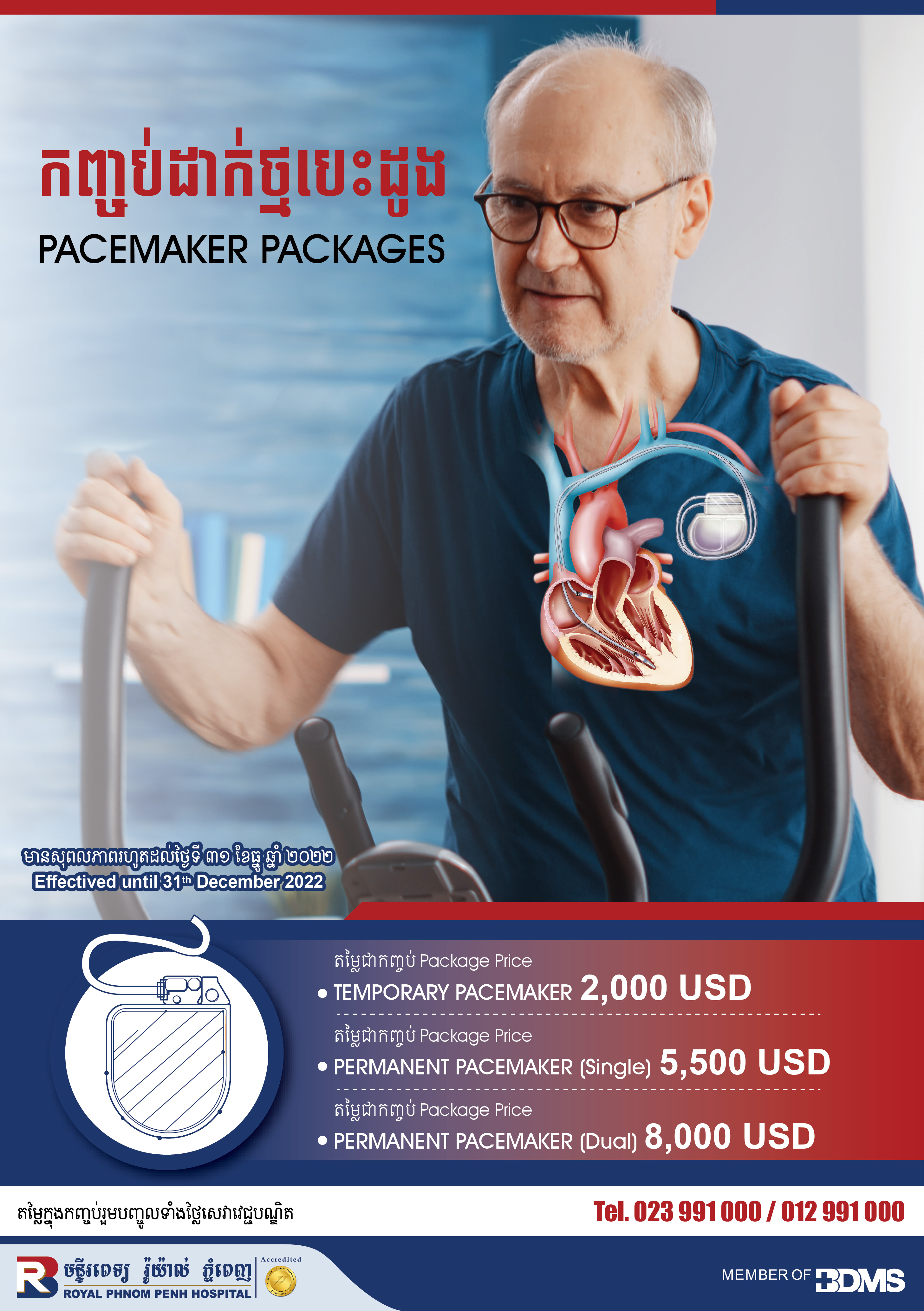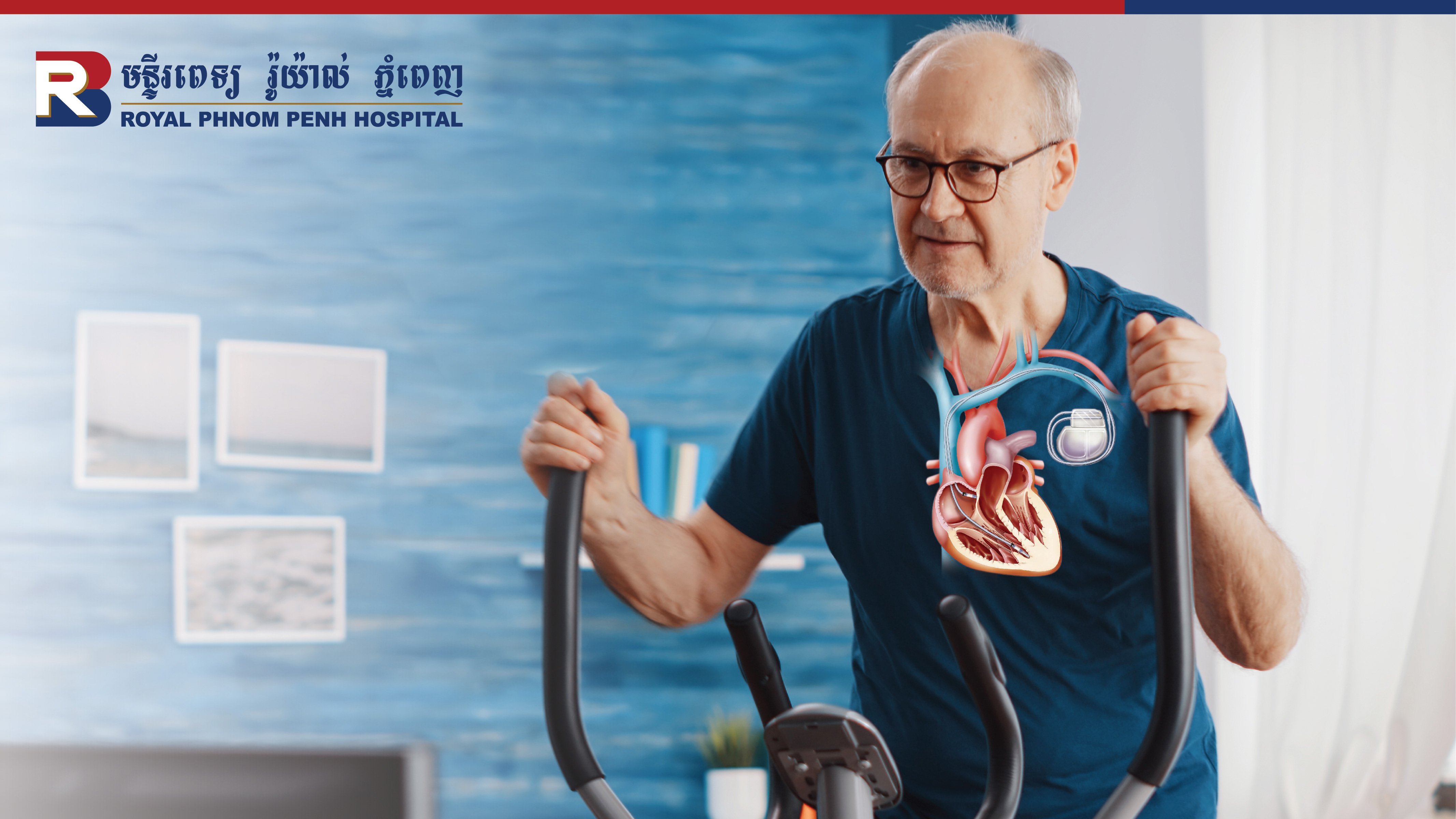PACEMAKER
DR. SANTI KIJSIRIWISAL
Cardiologist, Royal Phnom Penh Hospital
PACEMAKER is a piece of electronic equipment to stimulate the heart rhythm and corrects a slower heart rhythm.
When the heart beats slower than normal. It will not be able to pump enough blood to the other organs in the body causing the patient to feel weak and lack energy, and some may lose consciousness.
The pacemaker It sends electrical signals to the abnormally functioning chambers of the heart and helps your heart beat fast enough to pump blood to your body and other organs.
The components of the pacemaker include:
- battery
- pulse generator
- electrical lead and electrode
It works by transmitting electrical signals to adjust the heart's beat at a faster pace.
What a pacemaker does?
Pacemakers work only when needed. If your heartbeat is too slow (bradycardia), the pacemaker sends electrical signals to your heart to increase the beat.
Some newer pacemakers also have sensors that detect body motion or breathing rate and signal the devices to increase heart rate during exercise, as needed.
Who need Pacemaker?
The most common reason people get a pacemaker is their heart beats too slowly, or it pauses, causing fainting spells or other symptoms.
In some cases, the pacemaker may also be used to prevent or treat a heartbeat that is too fast (tachycardia) or irregular.
Test to done before decides for pacemaker?
- Electrocardiogram (ECG or EKG). An EKG can show Rhythm ,Rate and other abnormality of heart
- Holter monitoring. A small, wearable device that keeps track of the heart's rhythm. Holter monitoring is especially useful in diagnosing heartbeat problems that occur at unpredictable times.
Some personal devices, such as smartwatches, offer electrocardiogram monitoring. Ask your doctor if this is an option for you.
- Echocardiogram. This noninvasive test uses echo waves to evaluate of the heart's size, structure and pumping.
- Stress test. In case of suspect Coronary artery disease stress test may consider
A pacemaker can be applied in two ways
The physician will consider the patient's age, health, underlying disease, and lifestyle.
- Transient heart pacemaker There are both external and internal use. It is mainly used in emergency cases and emergency patients.
- Permanent heart pacemaker This is the surgical implantation of a pacemaker. It is mainly used in patients diagnosed with bradycardia who must use a pacemaker for a long time or life.
Preparation before inserting a pacemaker
- Abstain from water and food for at least 8 hours
- Remove any accessories or jewelry stored such as hearing aids, dentures, eyeglasses, necklaces, earrings, etc.
- The medical staff will shave the chest hair. next to the pacemaker In the case of right-handed people, it will be worn on the left side. If you're left-handed, you'll wear the right side.
Recommend after the pacemaker insertion
- Patients must stay in the intensive care unit to closely monitor the symptoms
- The same arm with the pacemaker should not be raised above the shoulder.
- Avoid strenuous activities.
- Do not lift heavy objects for at least 1 month.
- See your doctor for follow-up appointment
Are there any risks or complications that will occur?
- In the short term, the wound at the insertion site may be swollen and bruised. especially patients receiving fibrinolytic drugs
- The line is shifted or falls out of position (rare)
- Irregular heartbeat associated with implantation (rare)
- Bleeding, pain, or swelling where the device was inserted
- have a fever
- chest pain or shortness of breath
Special advice
- Cellphones. It's safe to talk on a cellphone, but should keep cellphone at least 6 inches (15 centimeters) away from pacemaker.
Don't keep your phone in a shirt pocket. When talking on your phone, hold it to the ear opposite the side where your pacemaker was implanted.
- Security systems. Passing through an airport metal detector won't interfere with your pacemaker, although the metal in the pacemaker could sound the alarm.
To avoid potential problems, carry an ID card stating that you have a pacemaker.
- Medical equipment.
Make sure all your doctors and dentists know you have a pacemaker.
Certain medical procedures, such as magnetic resonance imaging, CT scans, cancer radiation treatment, electrocautery to control bleeding during surgery, and shock wave lithotripsy to break up large kidney stones or gallstones could interfere with your pacemaker.
- Power-generating equipment. Stand at least 2 feet (61 centimeters) from welding equipment
- Devices that are unlikely to interfere with your pacemaker include microwave ovens, televisions and remote controls, radios, toasters, electric blankets, electric shavers, and electric drills.








